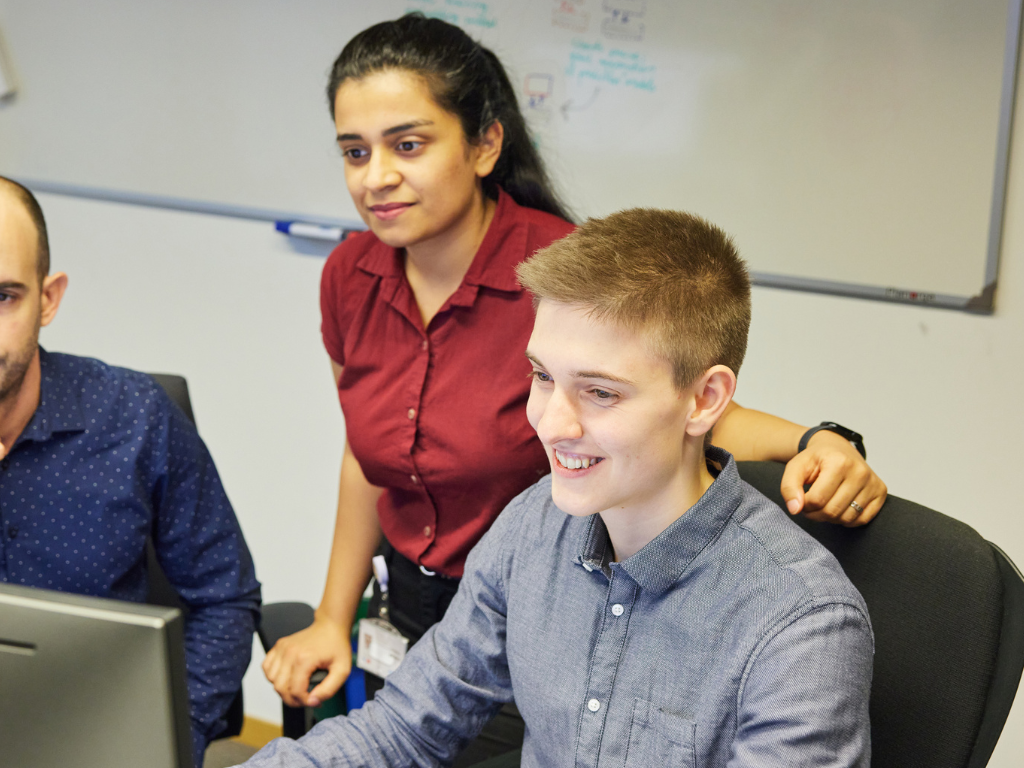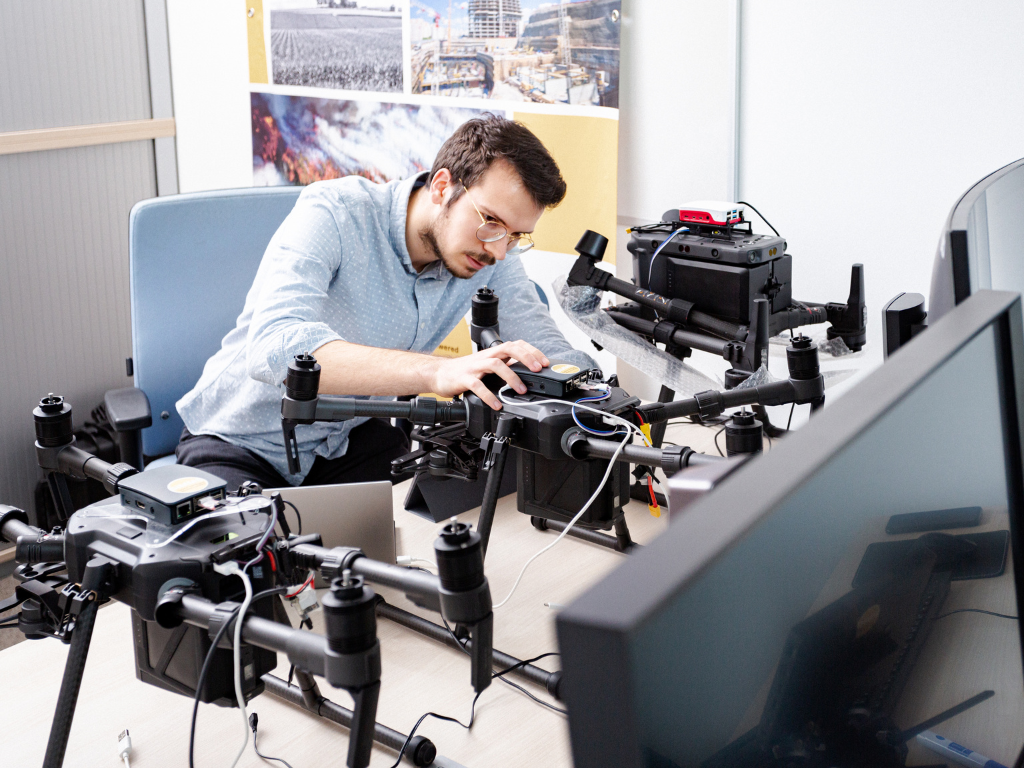Our Research
Solving complex problems in a fraction of the time
Solving today’s scientific and real-world problems not only requires high-performance computing (HPC), but also new generations of artificial intelligence algorithms. PCOG conducts research in parallel computing, search and optimisation techniques, to provide efficient, scalable and robust solutions to state-of-the-art, large-scale discrete/combinatorial problems.
Bringing Research
and Standardisation
Closer in Luxembourg

Research projects
Our Projects
-
Duration:
36 months
-
Funding source:
FNR CORE
-
Researchers:
Grégoire Danoy (PI), Pascal Bouvry, Sebastien Varrette, Daniel H. Stolfi, Florian Felten, Pierre-Yves Houitte
-
Partners:
N/A
-
Description:
The ADARS (Automating the Design of Autonomous Robot Swarms) project aims to propose a unique approach to automatically generate behaviours for distributed aerospace and space systems (DASS) thanks to a cross-fertilisation between multi-objective optimisation and machine learning techniques. ADARS will demonstrate through specifically designed software simulations and real field tests with multi-rotor drones, that state-of-the-art results can be obtained on two challenging DASS applications: swarm formation for a counter UAV system and swarm formation of small satellites for asteroid observation.
-
Project details (PDF):
-
Duration:
36 months
-
Funding source:
FNR CORE
-
Researchers:
Pierre Talbot (PI), Pascal Bouvry, Thibault Falque
-
Partners:
N/A
-
Description:
Graphics cards are components routinely available in personal computers, mobile phones and game consoles. They are very efficient to process and display on the screen complex graphism as employed in video games. Graphics cards are composed of numerous small processors, that make them very difficult to program beyond their initial graphics purposes.
COMOC intends to design a new way to program these cards, that will help to leverage the power of graphics cards to artificial intelligence applications. We will program in our new framework a software which will be able to solve problems from various fields such as operation research, healthcare and sustainable development. -
Project details (PDF):
-
Duration:
36 months
-
Funding source:
FNR CORE
-
Researchers:
Pascal Bouvry (PI), Caesar Wu
-
Partners:
N/A
-
Description:
The primary goal of the CBD project is to construct a novel knowledge representation that can capture multiple frames of the human decision process. Moreover, we can define a loss function, such as utility, belief, and crowd of wisdom, based on the knowledge representation. Finally, we can select the right optimizer for the loss function.
The project will also advance the strategic decision-making theory by publishing six papers in a high-quality conference or journal.
The CBD will produce and launch a prototype of the program via a web portal that allows Luxembourg’s organisation or SME to assist their strategic decision-making process.” -
Project details (PDF):
-
Duration:
48 months
-
Funding source:
Partnership Programme
-
Researchers:
Pascal Bouvry (PI), Ovidiu-Cristian Marcu, Md Mafizur Rahman
-
Partners:
LuxProvide
-
Description:
Ergonomics, high-performance, rich functionality, flexibility, automation, and intuitiveness are key differentiators which constitute a unique value proposition of the proposed HPC access system. To meet this broad range of features, the project will study state of the art of the design, architecture, and functionality of most used HPC systems in comparison with MeluXina, understanding typical patterns of interactions with HPC by different users, define and design a set of requirements for the bridging of Clouds and HPC platform (work done in collaboration with LuxProvide), identify the core issues at the core of the requirements and core research challenges. Focus will be put on high-performance, jobs interoperability, Data/AI workflow exchanges, ease of use and architectural implications. Through friendly user interfaces and APIs, users will navigate and leverage computation and storage resources while real-time monitoring will be used in order to give visibility into security threats and act for ensuring secure access to the HPC resources.
-
Project details (PDF):
-
Duration:
48 months
-
Funding source:
Partnership Programme
-
Researchers:
Pascal Bouvry (PI), Grégoire Danoy, Mohammed Alswaitti, Manuel Combaro Simon, Hedieh Haddad, Lena Maria Hartmann
-
Partners:
ILNAS
-
Description:
ILNAS-SnT research programme 2021-2024 is sector-oriented and targets three highly relevant growth sectors for Luxembourg’s economy, in conformity with the national technical standardization strategy 2020-2030, that will deepen data and AI capabilities and enable a steady potential for innovation. The three sectors are ICT, aerospace, and construction. The economic power for these three domains is strongly determined by normative values notably related to trustworthiness, security, and privacy. Consequently, policies, regulations, and standards are required to be established to enhance trust in each particular domain-specific ecosystem.
-
Project details (PDF):
-
Duration:
42 months
-
Funding source:
FNR INTER
-
Researchers:
Grégoire Danoy (PI), Pascal Bouvry, Gwen Maudet, Alisa Vorokhta, Guillaume Helbecque
-
Partners:
University of Lille, France
-
Description:
According to Top500 modern supercomputers are increasingly large (millions of cores), heterogeneous (CPU-GPU, …) and less reliable (MTBF<1h) making their programming more complex. The development of parallel algorithms for these ultrascale supercomputers is in its infancy especially in combinatorial optimization. Our objective is to investigate the Partitioned Global Address Space (PGAS) paradigm for the productivity- and performance-aware design and implementation of exact algorithms (e.g. B&B) and metaheuristics (e.g. EAs) for solving challenging optimisation problem instances.
We will address in a holistic way (uncommon) three roadblocks on the road to exascale: locality-aware ultrascalability, CPU-GPU heterogeneity and checkpointing-based fault tolerance. Our application challenge is to solve to optimality very hard benchmark instances (e.g. Flowshop ones unsolved since 25 years). The Jean Zay (France) and ULPHC (University of Luxembourg) petascale supercomputers will be used for experimentation.
-
Project details (PDF):
-
Duration:
48 months
-
Funding source:
FNR INTER
-
Researchers:
Grégoire Danoy (PI), Pascal Bouvry, Pierre Talbot, Yi-Nung Tsao
-
Partners:
University of Lorraine, France
-
Description:
Real-world applications in Optimisation (Vehicle Routing Problem) and Machine Learning (Image recognition) are very challenging due to their large-scale structure. To cope with this issue, decomposition techniques have been historically introduced in mathematical programming. These techniques split a given problem into smaller and more affordable subproblems which are subsequently solved. Column Generation is a reference on this matter but suffers from certain pathologies that we first propose to tackled using Learning approaches.
In the same vein, Machine Learning (ML) models keeps growing and become time-consuming and energy-hungry models that can only be tackled with High-Performance Computing platforms. Nonethless, ML experts and academics did not inspired from mathematical programming and the decompostion techniques developed in the same context but in a different field.
In the ADHOC project, we are going to transpose and adapt decomposition techniques to ML models which are intrisically otpimisation problems. -
Project details (PDF):
-
Duration:
36 months
-
Funding source:
FNR CORE International
-
Researchers:
Grégoire Danoy (PI Luxembourg) Pascal Bouvry, Imane Hocine, Ezhilmathi Krishnasamy
-
Partners:
Poznań University of Technology (PUT), Poland
-
Description:
The Global Navigation Satellite System and Earth Observation market had revenues of around €200 billion in 2021 and is expected to reach €500 billion by 2031. Many satellites from different vendors are carrying out their work in space. Additionally, all the data they acquire (images, recordings, analysis, raw data, etc.) may be offered by different providers. The huge amount of collected data requires appropriate storage, classification, and further processing for final use. Data
lakes are the place where any data can be stored. The relative initial maturity of this market shows many aspects that can be dramatically improved to achieve much better end benefits – and for all parties to the transaction.
In the current context, many customers might be interested in combining data of two or more satellite data providers, e.g., to obtain more frequent data or to merge data of several types. To this end, the customer needs to request data separately from each provider. Such a scenario is sub-optimal since it requires the customer to know the different providers. A data marketplace is one promising solution for this problem. It is an online platform where users can sell or buy data from different sources.
The SpacE data bRokEriNg optImizaTion sYstem (SERENITY) project, aims to propose a novel type of marketplace where space data providers and consumers interact through a data broker that relies on a data lake storage. To this end, the SERENITY project will develop novel artificial intelligence and data storage approaches that will permit to tackle objectives like maximising providers’ profits, optimising data latency and minimising total purchase cost for customers. -
Project details (PDF):
